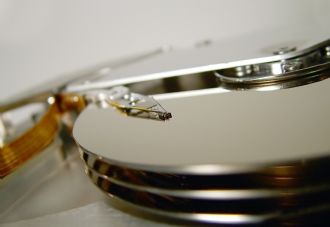For more than 50 years, hard disk drives have run on air, but that is now about to change. Western Digital is preparing to launch a line of hard drives filled with helium gas that is said to drastically reduce internal friction and thus lower power consumption by 23% while increasing capacity by 40%.
The 3.5" data centre drives, developed by WD subsidiary Hitachi Global Storage Technologies (HGST), are expected to be available next year. The hermetically sealed drives are filled with helium, which is one-seventh the density of air.
Brendan Collins, vice president of product marketing at HGST, said helium drives reduce drag on the disk’s platters while the seals keep humidity and other contaminates out. Less drag means the drives operate at temperatures that are four to five degrees cooler than today’s 7,200 rpm drives, Collins added.
A sealed drive can also operate in more severe environmental conditions, according to HGST.
"The industry has been trying to make this work for the past 10 years. They’ve been trying to ensure that the gas doesn’t leak and that the drives can be efficiently produced in mass volume. That’s the key to our proprietary technology," Collins said.
Collins called HGST’s announcement more of a technology platform than a product. The helium-filled drives will be targeted for use in public cloud computing systems and in corporate data centres, he added.
"We believe the technology will be around for the next 10 years and will be the foundation of cloud-based storage in the data centre," Collins said.
The helium gas-filled drives will let HGST increase the overall platter count from five to seven. At the same time, the technology allows for increasing platter density-with more tracks per square inch.
HGST also expects to use helium drives for new, higher capacity drive technologies such as Heat Assisted Magnetic Recording (HAMR) and Shingled Magnetic Recording.
Both HAMR and SMR are about two years away from production, Collins said.
"I’m really interested to see how people react to [helium-filled drives]," said IDC analyst John Rydning. "I don’t think people are aware that it’s been in development for a long time."
Today, HGST data centre drives offer up to 4TB of capacity on five internal platters. While HGST would not say what capacity the helium-filled drives will sport, it could be as much as 5.6TB based on the company’s estimate of a 40% increase over current technologies.
Capacity limitations
All drive makers have been closing in on a storage ceiling due to disk platter wobble or vibration that comes with spinning at thousands of revolutions per minute.
The speedy spinning motion causes air turbulence, which in turn disrupts both the platter and the read/write head’s ability to remain on track. The phenomenon is known as track misregistration (TMR), a problem that has been exacerbated as tracks are pushed closer together.
A decade ago, for instance, technology allowed for a maximum of 100,000 tracks per inch on a disk drive’s platter. Today’s technology lets manufacturers offer up to 500,000 tracks per inch, according to Rydning.
"That’s where you’re reaching the point where it’s getting hard to keep the head over the track," Rydning said.
By using the light gas helium, HGST all but eliminated internal turbulence on the 7,200rpm drives, thereby overcoming the TMR roadblock. By reducing TMR, manufacturers should be able to use thinner platters, Rydning said.
HGST said the new seven-platter helium drives will weigh 29% less per terabyte of capacity that today’s five-platter drives. In other words, a seven-platter helium disk will weigh 690 grams, the same as today’s five-platter drives.
Reducing drag on the platters will also allow HGST’s new helium drives to use 23% less spindle power to turn. A five-platter drive today draws 6.9 watts while idle. The new seven-platter helium drives will draw 5.3 watts of power in the same state.
The seven-platter, 3.5" helium drives will also have a 50% lower cost per gigabyte than 2.5" four-platter hard drives, Collins said.
In addition to lower unit cost, the higher capacity drives mean it will take fewer servers to fill the same data centre space. For example, a petabyte of data today requires 20 servers using five-platter, 4TB drives. Using the seven-platter drives, the same data can be stored in only 14 servers, Collins said.
Collins said there are "tectonic shifts" happening as corporate data centres move from the Windows/Intel architecture to standardised hardware and software.
"Data centres are becoming more customised and using more open-source hardware and software," Collins said. "We’re seeing a lot of cloud customers designing their own servers, file systems and software stacks."
For data protection, for example, IT shops are moving away from more expensive RAID arrays to using distributed storage infrastructures that uses data replication and erasure coding technologies for data durability.
An enormous portion, up to 40%, of the costs in new cloud based data centres will be attributed to operational costs such as power use and floor space, Collins said. Today the bulk of data centre costs are capital expenditures, including hardware purchases.
"This is driving a lot of opportunities to differentiate products in the cloud," Collins said. "The attributes of the sealed drive platform make it the ideal foundation for bulk and cold storage applications in enterprise and cloud datacentres."
IDG News Service








Subscribers 0
Fans 0
Followers 0
Followers